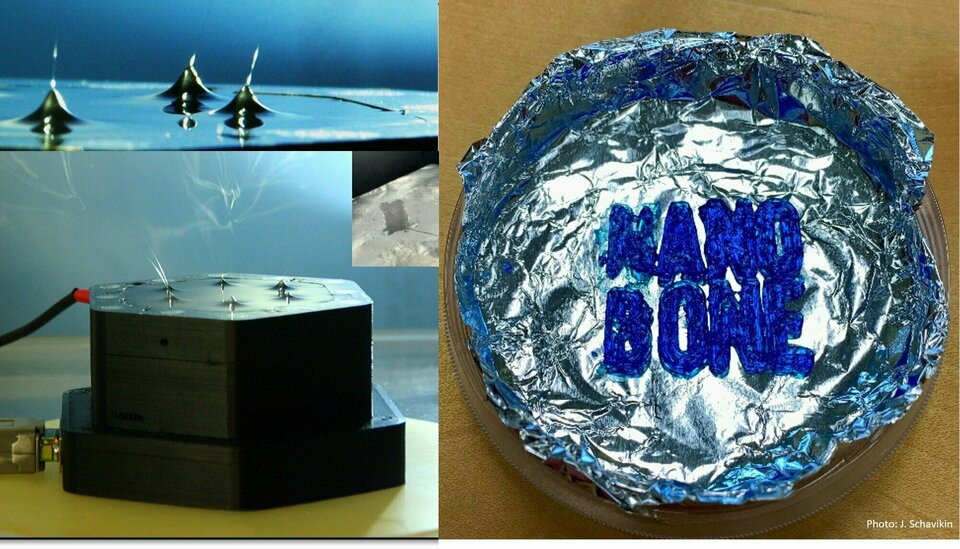Research projects
Research work at the Institute of Pharmacy is multidicsiplinary and involves the following research areas:
- Estonian pharmacy terminology,
- pharmacy history,
- pharmaceutical technology,
- biopharmaceutics,
- physical pharmacy,
- pharmaceutical nanotechnology,
- pharmacognosy,
- social pharmacy,
- clinical pharmacy.
Pharmaceutical chemistry research work is currently related with all other research areas.
Major research projects
“NanoBone” – Multifunctional composites of nanofiber-based 3D-bioprinted constructs for bone tissue engineering (2023-2026)
PRG1903, Professor J. Heinämäki, University of Tartu, Faculty of Medicine, Institute of Pharmacy (coordinator).
The project aims to develop and test novel biomimetic composite of nanofibrous and three-dimensional (3D) bioprinted bone tissue constructs intended for use in bone regeneration and tissue modeling for studying disease and testing drugs.
To design such constructs, we will investigate how structural features and functions of native bone tissue can be mimicked in engineered constructs using novel biomaterial that has osteopromotive, angiogenic and antibacterial properties combined at the nanostructure. We will also develop our patented ultrasound-enhanced electrospinning method to suit the production of the biomimetic nanofibers (NFs) needed for this project. We will investigate cellular responses to mechanical microenvironments created by the NF-3D bioprinted biomimetic composites to better define the properties of engineered bone construct.
Knowledge obtained from the present research activities will be exploited for designing new regenerative and modeling of bone tissue.

Multifunctional nanomedicines – design and quality assessment (2015-2020)
IUT34-18 , Prof. J. Heinämäki, University of Tartu, Faculty of Medicine, Institute of Pharmacy (coordinator).
The project investigates the formulation and manufacturing technologies of new multifunctional nanomedicines potentially applicable in the treatment of the major diseases today.
The project comprises three Work Packages (WPs):
- WP1 – Nanomedicines of poorly water-soluble drugs,
- WP2 - Multifunctional nanomedicines for wound therapy and
- WP3 - Printed nanomaterial substrates and drug delivery systems for personalized drug therapy.
At the end of the project, new nanomaterial drug products and manufacturing technologies for poorly water-soluble drugs and wound healing therapy are developed. Printed personalized medicines intended for pediatric and geriatric drug therapy are available.
Special attention is paid on a high-level research training in pharmaceutical nanotechnology and strengthening the knowledge on this research in Estonia.
ACOUSPIN, “Accelerated wound healing” (2018-2019This is the research service and collaboration project with the University of Helsinki, Finland.
Group leader at the University of Tartu Prof. J. Heinämäki. Director in charge and project leader Prof. E. Haeggström, University of Helsinki.
The focus of this research project was to develop a multlmodal Acouspin system (USES) that combines intense ultrasound (US) and electrospinning (ES) to generate novel kinds of nanofiber networks intended for acute and/or chronic wound dressings.
The Acouspin technique permits temporal and spatial US control of the structure of nanofibrous platforms and control of the content of individual fibers.
This permits one to modify the rnedranical and micro- and nanotopographic properties of individual fibers and fiber constructs. It is possible to e.g. match the needs of specific tissues and to tune the porosity of the construct to control gas permeatiory cell infiltration, and absorption of wound exudates.
- "Pharmacognostic and pytochemical investigation of plant material of Estonian origin and from different other countries”
Prof. A. Raal, University of Tartu, Faculty of Medicine, Institute of Pharmacy (coordinator).
- PHAR-QA (Quality Assurance in European Pharmacy Education and Training),
Associate prof. D. Volmer, University of Tartu, Faculty of Medicine, Institute of Pharmacy (partner)
- Pharmcognosy and pharmaceutical analysis
- Social pharmacy and clinical pharmacy
- Pharmacy history
- Estonian pharmaceutical terminology



